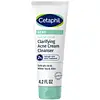What's inside
What's inside
 Key Ingredients
Key Ingredients

 Benefits
Benefits

 Concerns
Concerns

 Ingredients Side-by-side
Ingredients Side-by-side

Water
Skin ConditioningGlycerin
HumectantCocamidopropyl Betaine
CleansingDecyl Glucoside
CleansingCitric Acid
BufferingPPG-2 Hydroxyethyl Cocamide
EmulsifyingPEG-16 Soy Sterol
EmulsifyingPolysorbate 20
EmulsifyingDisodium Lauroamphodiacetate
CleansingPhenoxyethanol
PreservativeButylene Glycol
HumectantSodium Coco Pg-Dimonium Chloride Phosphate
CleansingSodium Citrate
BufferingTetrasodium EDTA
Methylparaben
PreservativeXanthan Gum
EmulsifyingPropylparaben
PreservativeEthylparaben
PreservativePropylene Glycol
HumectantChrysanthemum Parthenium Extract
Skin ConditioningSodium Cocoyl Amino Acids
CleansingSarcosine
Skin ConditioningPotassium Aspartate
Skin ConditioningMagnesium Aspartate
Skin ConditioningSodium Hydroxide
BufferingWater, Glycerin, Cocamidopropyl Betaine, Decyl Glucoside, Citric Acid, PPG-2 Hydroxyethyl Cocamide, PEG-16 Soy Sterol, Polysorbate 20, Disodium Lauroamphodiacetate, Phenoxyethanol, Butylene Glycol, Sodium Coco Pg-Dimonium Chloride Phosphate, Sodium Citrate, Tetrasodium EDTA, Methylparaben, Xanthan Gum, Propylparaben, Ethylparaben, Propylene Glycol, Chrysanthemum Parthenium Extract, Sodium Cocoyl Amino Acids, Sarcosine, Potassium Aspartate, Magnesium Aspartate, Sodium Hydroxide
Water
Skin ConditioningCocamidopropyl Betaine
CleansingDistearyl Phthalic Acid Amide
EmollientSodium Methyl Cocoyl Taurate
CleansingSodium Chloride
MaskingCetyl Alcohol
EmollientStearyl Alcohol
EmollientPEG-120 Methyl Glucose Dioleate
EmulsifyingPhenoxyethanol
PreservativeSodium Hydroxide
BufferingCaprylyl Glycol
EmollientEthylhexylglycerin
Skin ConditioningHexylene Glycol
EmulsifyingDisodium EDTA
Isopropyl Alcohol
SolventAloe Barbadensis Leaf Juice
Skin ConditioningButylene Glycol
HumectantCamellia Sinensis Leaf Extract
AntimicrobialWater, Cocamidopropyl Betaine, Distearyl Phthalic Acid Amide, Sodium Methyl Cocoyl Taurate, Sodium Chloride, Cetyl Alcohol, Stearyl Alcohol, PEG-120 Methyl Glucose Dioleate, Phenoxyethanol, Sodium Hydroxide, Caprylyl Glycol, Ethylhexylglycerin, Hexylene Glycol, Disodium EDTA, Isopropyl Alcohol, Aloe Barbadensis Leaf Juice, Butylene Glycol, Camellia Sinensis Leaf Extract
 Reviews
Reviews

Ingredients Explained
These ingredients are found in both products.
Ingredients higher up in an ingredient list are typically present in a larger amount.
Butylene Glycol (or BG) is used within cosmetic products for a few different reasons:
Overall, Butylene Glycol is a safe and well-rounded ingredient that works well with other ingredients.
Though this ingredient works well with most skin types, some people with sensitive skin may experience a reaction such as allergic rashes, closed comedones, or itchiness.
Learn more about Butylene GlycolCocamidopropyl Betaine is a fatty acid created by mixing similar compounds in coconut oil and dimethylaminopropylamine, a compound with two amino groups.
This ingredient is a surfactant and cleanser. It helps gather the dirt, pollutants, and other impurities in your skin to be washed away. It also helps thicken a product and make the texture more creamy.
Being created from coconut oil means Cocamidopropyl Betaine is hydrating for the skin.
While Cocamidopropyl Betaine was believed to be an allergen, a study from 2012 disproved this. It found two compounds in unpure Cocamidopropyl Betaine to be the irritants: aminoamide and 3-dimethylaminopropylamine. High-grade and pure Cocamidopropyl Betaine did not induce allergic reactions during this study.
Learn more about Cocamidopropyl BetainePhenoxyethanol is a preservative that has germicide, antimicrobial, and aromatic properties. Studies show that phenoxyethanol can prevent microbial growth. By itself, it has a scent that is similar to that of a rose.
It's often used in formulations along with Caprylyl Glycol to preserve the shelf life of products.
Sodium Hydroxide is also known as lye or caustic soda. It is used to adjust the pH of products; many ingredients require a specific pH to be effective.
In small amounts, sodium hydroxide is considered safe to use. However, large amounts may cause chemical burns due to its high alkaline.
Your skin has a natural pH and acid mantle. This acid mantle helps prevent harmful bacteria from breaking through. The acid mantle also helps keep your skin hydrated.
"Alkaline" refers to a high pH level. A low pH level would be considered acidic.
Learn more about Sodium HydroxideWater. It's the most common cosmetic ingredient of all. You'll usually see it at the top of ingredient lists, meaning that it makes up the largest part of the product.
So why is it so popular? Water most often acts as a solvent - this means that it helps dissolve other ingredients into the formulation.
You'll also recognize water as that liquid we all need to stay alive. If you see this, drink a glass of water. Stay hydrated!
Learn more about Water